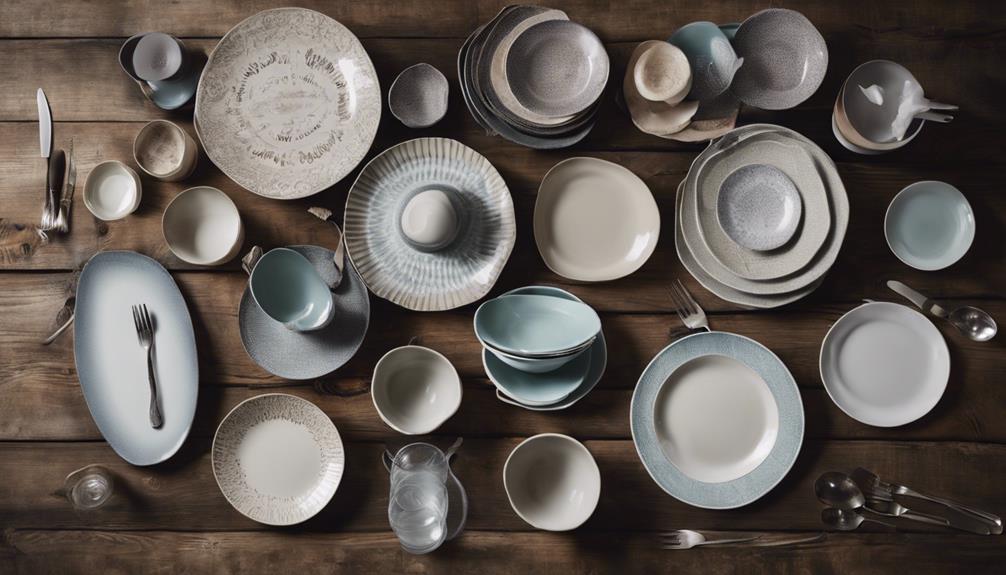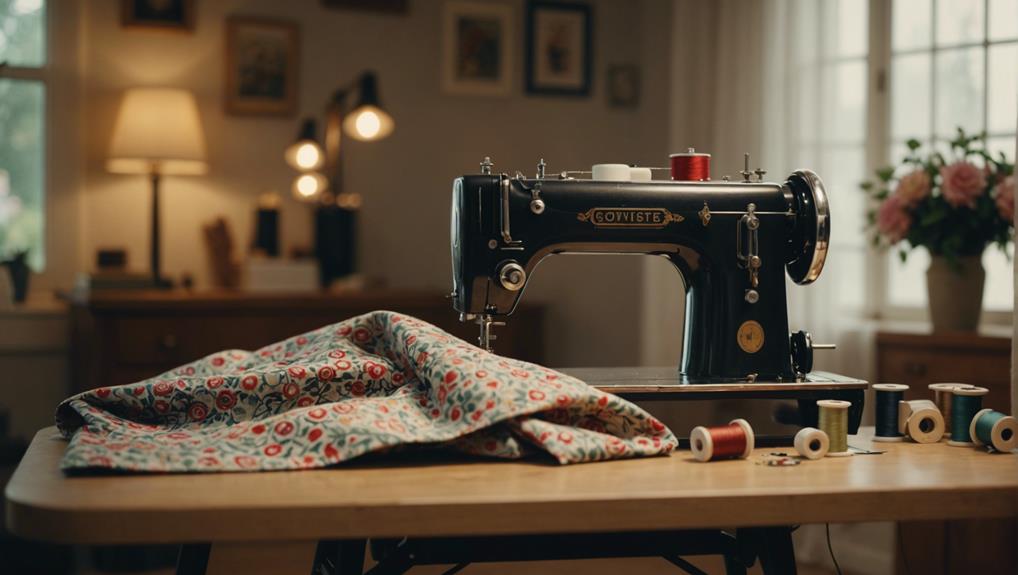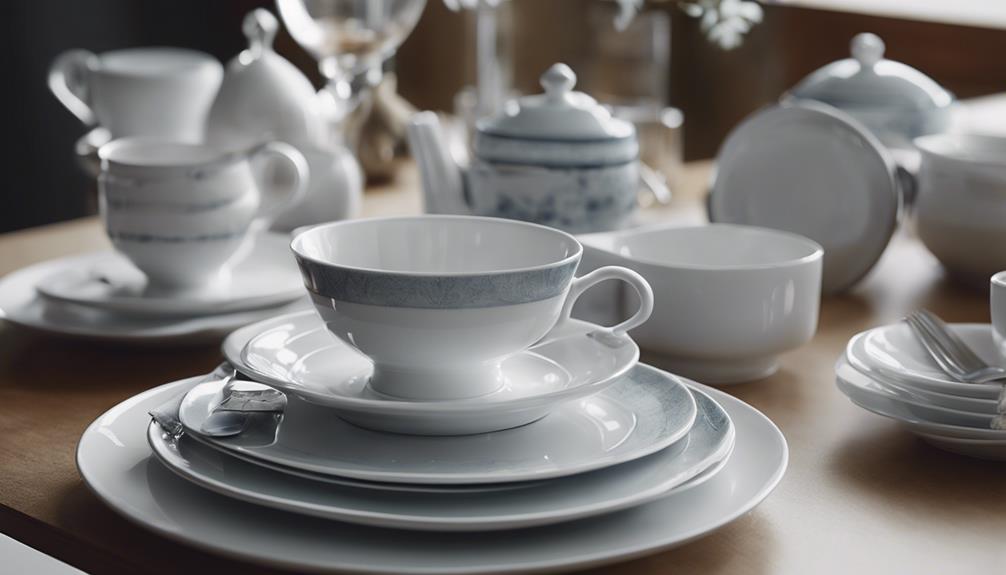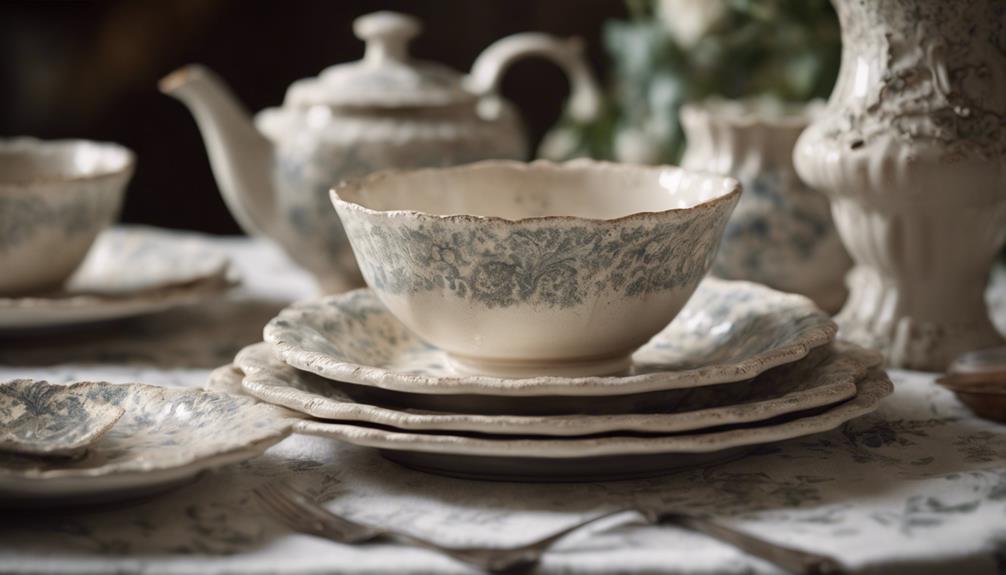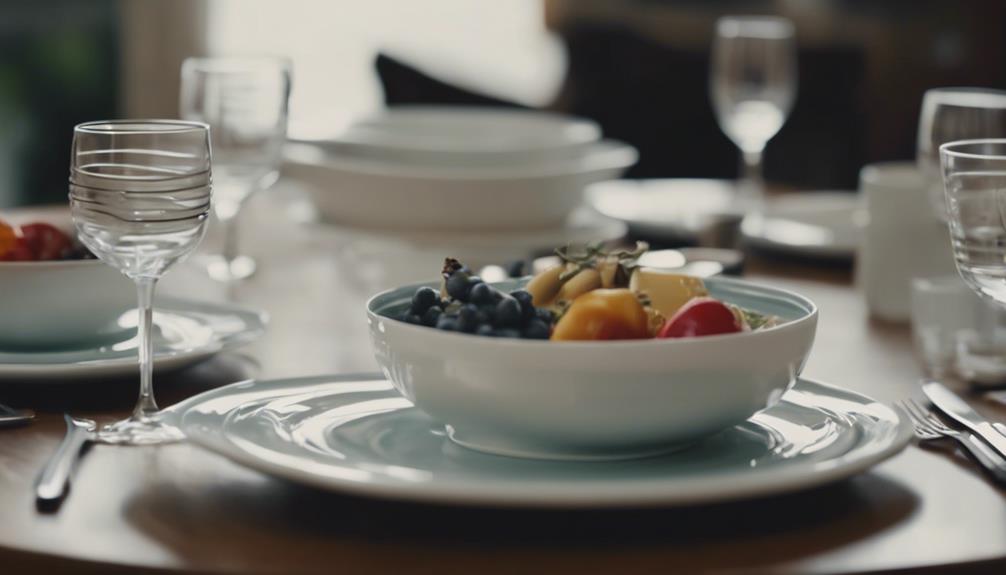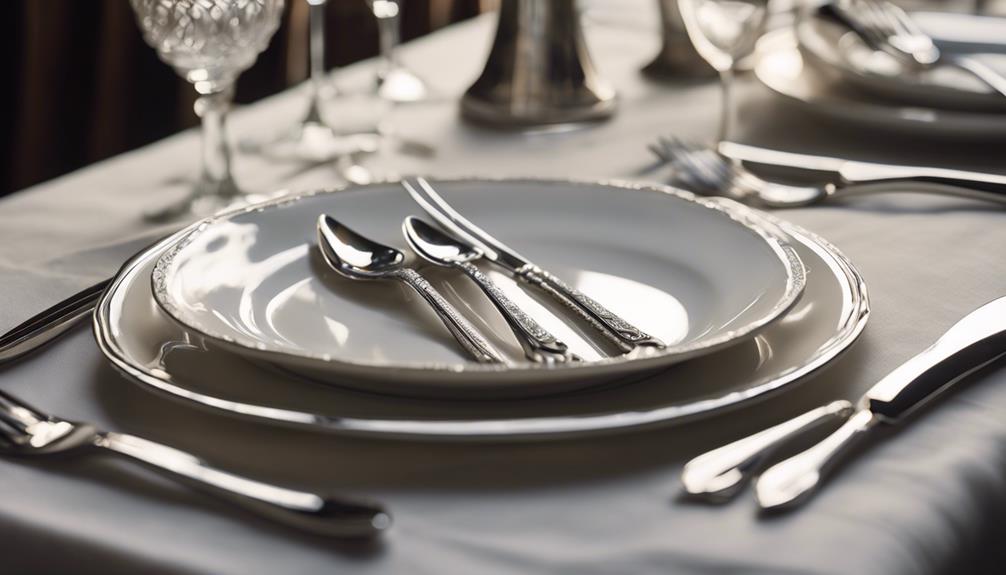Yes, tableware is a legitimate term that includes dishes, glassware, and silverware for setting meals, blending functionality and visual appeal in dining customs. It comes from the Middle English word ‘tabelware,’ which is derived from Old English ‘tabele’ and ‘ware.’ This expression encompasses a broad range of materials like ceramic, glass, metal, and plastic, catering to various preferences. Tableware enhances the presentation, atmosphere, and overall experience of dining, crucial in both hospitality and everyday meals. Understanding this term sheds light on its importance in setting tables correctly. For more insights into the diverse world of tableware, delve deeper into information on its evolution, materials, and cultural significance.
Key Takeaways
- Yes, 'Tableware' is a real word in the English language.
- It originated from Middle English and Old English terms.
- Tableware encompasses dishes, glassware, and silverware.
- The term signifies items used for table settings and dining.
- It holds cultural, historical, and functional significance in dining contexts.
Definition of Tableware
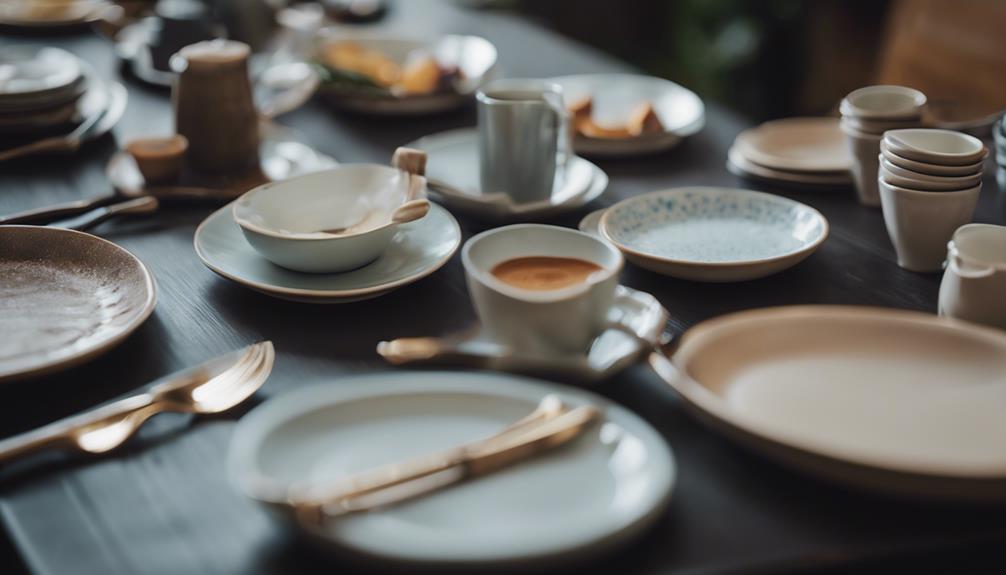
Tableware refers to dishes, glassware, and silverware utilized in setting a table for a meal. It includes items such as plates, knives, forks, and other utensils used during meals. Tableware encompasses all the essential items needed for dining experiences and meal settings. These pieces play an important role in enhancing the presentation and functionality of a table during meals.
Having the right tableware is essential for creating a pleasant dining atmosphere. The variety of dishes, glassware, and silverware available lets you set the table according to different occasions and personal preferences. Not only does tableware serve a practical function in serving and enjoying food, but it also adds style and elegance to the dining experience. Choosing the appropriate tableware can elevate the overall dining experience, making meals more enjoyable and visually appealing. Therefore, investing in quality tableware is a worthwhile choice for anyone looking to enhance their dining setup.
Origin and Etymology of Tableware
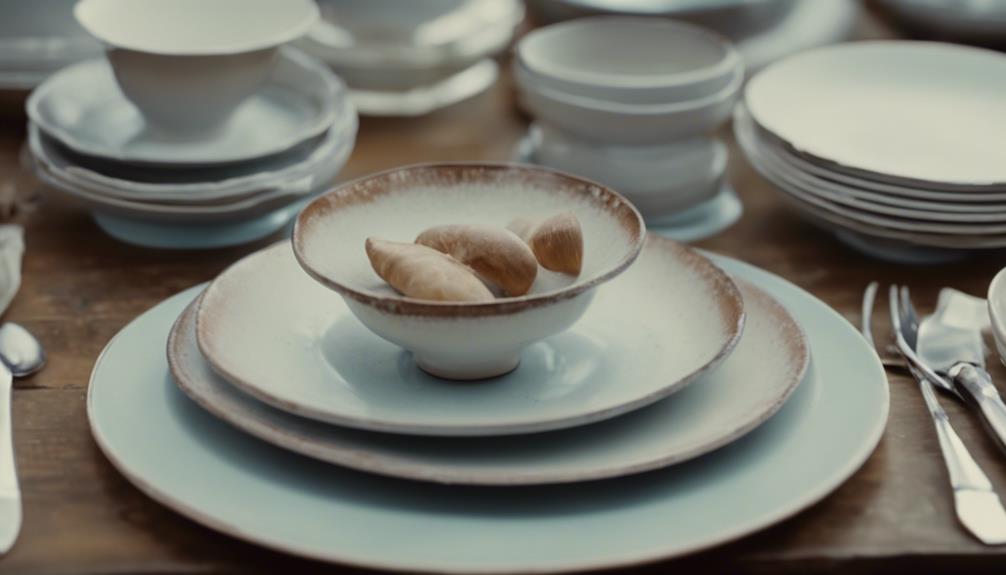
Understanding the historical roots and linguistic evolution of the term 'tableware' sheds light on its significance in dining culture.
The word 'tableware' has its origins in the Middle English word 'tabelware,' which was derived from the Old English word 'tabele' meaning table and 'ware' referring to items or merchandise. This combination highlights the practical nature of these items used for setting tables and dining.
Over time, as dining customs evolved, the term 'tableware' came to encompass a wide range of objects such as dishes, plates, knives, forks, and more, essential for mealtime settings.
The etymology of 'tableware' emphasizes the functional and decorative aspects of these items, emphasizing their role in enhancing the dining experience and table presentation.
The evolution of the term mirrors the development of dining culture, highlighting the importance of tableware in both practical and aesthetic terms.
Types of Tableware
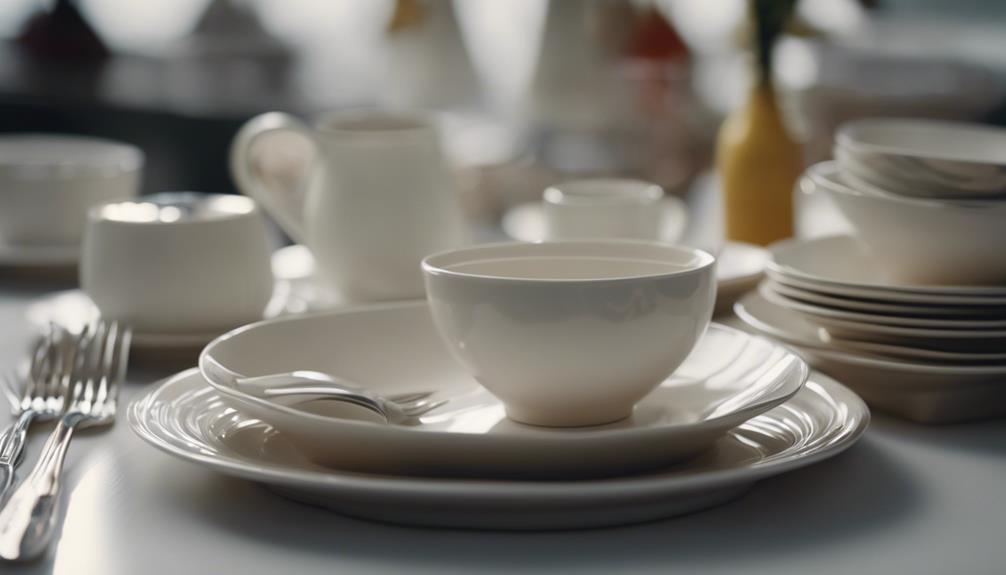
When considering the array of tableware options available, you'll find a diverse range of materials and styles to suit various dining preferences and occasions. Table settings can include dishes, plates, glassware, and silverware to enhance the dining experience. Different materials such as ceramic, glass, metal, and plastic are used to manufacture these items. Ceramic tableware offers durability and versatility, while glassware adds an elegant touch to table settings. Metal utensils provide a classic look and feel, and plastic tableware is practical for outdoor dining or casual settings.
Moreover, tableware includes essential items like knives, forks, spoons, and serving dishes that play an important role in dining. These items not only serve functional purposes but also reflect cultural nuances and add elegance to table settings. The dynamic tableware market is witnessing a shift towards eco-friendly options like compostable tableware to address environmental concerns. Whether it's a formal dinner party or a casual brunch, choosing the right tableware can elevate the dining experience and set the tone for the occasion.
Importance of Tableware in Dining
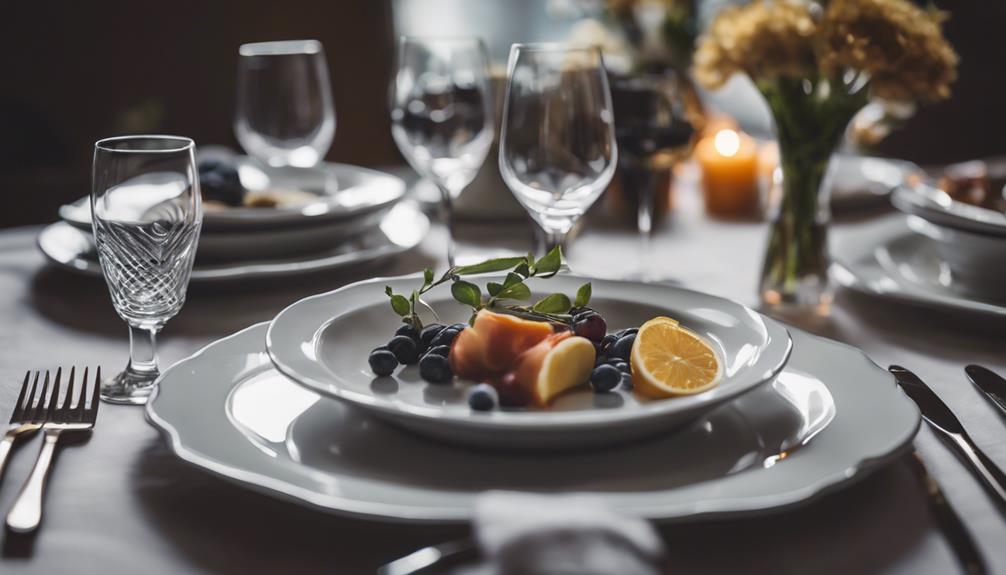
Tableware plays an essential role in dining by enhancing presentation, setting the ambiance, and influencing the overall experience.
The way you arrange your tableware can greatly impact the way a meal is perceived.
From elegant plates to intricate cutlery, tableware holds the power to elevate your dining experience.
Tableware Enhances Presentation
Enhancing the dining experience, ceramic tableware plays a pivotal role in setting the stage for a memorable meal. The elegant designs and cultural significance of Japanese ceramic tableware add a touch of sophistication to your dining table.
Whether it's a casual gathering or a formal dinner, the right choice of tableware can elevate the overall presentation and create a lasting impression on your guests. The classic look of ceramic tableware is perfect for Easter entertaining, bringing a timeless charm to the occasion.
With a wide range of designs and collections available, you can easily find the perfect ceramic tableware to suit your dining preferences and enhance the ambiance of any meal.
Tableware Sets Ambiance
The visual appeal of your dining experience is greatly influenced by the ambiance set through carefully selected tableware. The way you arrange your table setting with the right tableware can enhance the overall atmosphere of your meal. Different styles and designs of tableware can cater to various preferences and themes for dining events, reflecting cultural significance and traditions associated with dining.
Tableware Influences Experience
When dining, the selection of tableware greatly influences the overall experience, setting the tone for your meal and enhancing the ambiance. Tableware plays an essential role in reflecting the essence of Japanese cuisine culture, adding elegance and a wow factor to the dining table. It is integral for Easter entertaining, setting a classic and festive look for special occasions. The right tableware signifies the occasion and adds sophistication to the dining setting, elevating the experience by creating a visually appealing and cohesive presentation.
| Tableware Influences | Dining Experience | Aspect |
|---|---|---|
| Reflects Japanese Culture | Adds Elegance | Enhances Dining Ambiance |
| Essential for Easter | Sets Festive Look | Adds Sophistication |
| Signifies Occasion | Elevates Experience | Creates Visually Appealing Presentation |
Tableware in Hospitality Industry
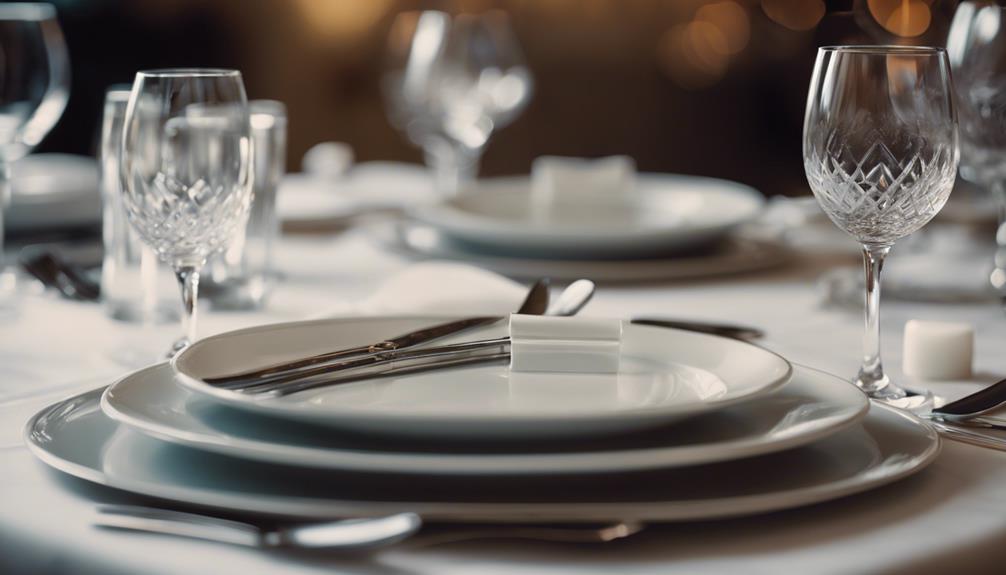
Tableware is essential in the hospitality industry as it plays a significant role in enhancing the dining experience for guests. Quality tableware not only elevates the presentation of food and beverages but also contributes to creating a memorable dining experience.
Hospitality establishments often invest in stylish and durable tableware to make a positive impression on their guests.
Role in Service
Enhancing the dining experience for guests in the hospitality industry, used cutlery is a fundamental component of tableware that plays a pivotal role through its ability to elevate ambiance and aesthetics.
The arrangement and presentation of cutlery, along with other tableware items like plates and glasses, contribute greatly to the overall dining setting. In restaurants, hotels, and catering services, the careful selection and proper placement of cutlery convey sophistication, attention to detail, and a commitment to quality service.
Guests often associate well-arranged cutlery with a higher level of service and overall satisfaction with their dining experience. As a result, the role of cutlery in service goes beyond its functional use, shaping perceptions and enhancing the overall ambiance in hospitality establishments.
Impact on Experience
Consider how the selection of tableware impacts the overall dining experience in the hospitality industry.
- The choice of tableware can greatly influence the perceived quality and sophistication of a dining establishment.
- Well-selected tableware can enhance the presentation of food and drinks, making them more visually appealing.
- Different styles of tableware can help convey specific themes or ambiance, contributing to the overall atmosphere of a restaurant.
- Tableware in the hospitality industry serves not only a functional purpose but also acts as a form of expression and branding for the establishment.
Tableware plays an important role in shaping the dining experience, from setting the tone of the meal to reflecting the identity of the establishment. The impact of tableware goes beyond mere functionality, influencing how guests perceive the quality and atmosphere of a dining venue.
Cultural Significance of Tableware
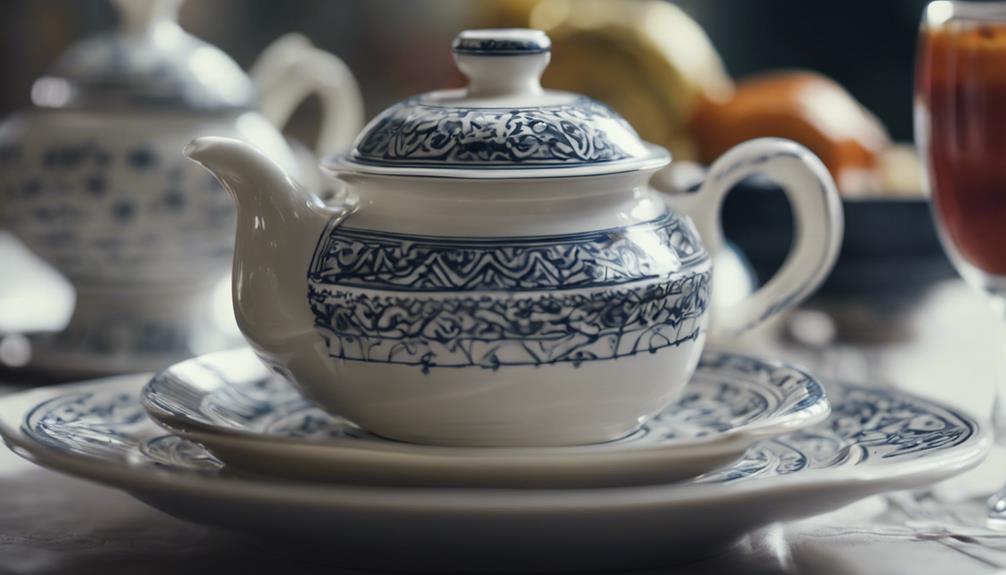
Throughout history, the use of tableware has served as a significant marker of social standing and cultural values. Eating utensils, a key component of tableware, have played a pivotal role in defining societal norms and practices. In various civilizations, the type and quality of utensils used during meals often reflected one's status and wealth. For instance, in medieval times, the wealthy showcased their affluence by using elaborate and ornate utensils made of precious metals, while the common folk resorted to simpler materials.
The cultural significance of tableware extended beyond mere functionality. It was intertwined with traditions, etiquette, and even laws. Sumptuary laws, which regulated what people could wear and use in their daily lives, also extended to tableware, further emphasizing its importance in reflecting social hierarchies. The evolution of eating utensils over time, from basic trenchers to intricate silverware, showcases how tableware evolved alongside human civilization, becoming a symbol of cultural heritage and societal values.
Evolution of Tableware
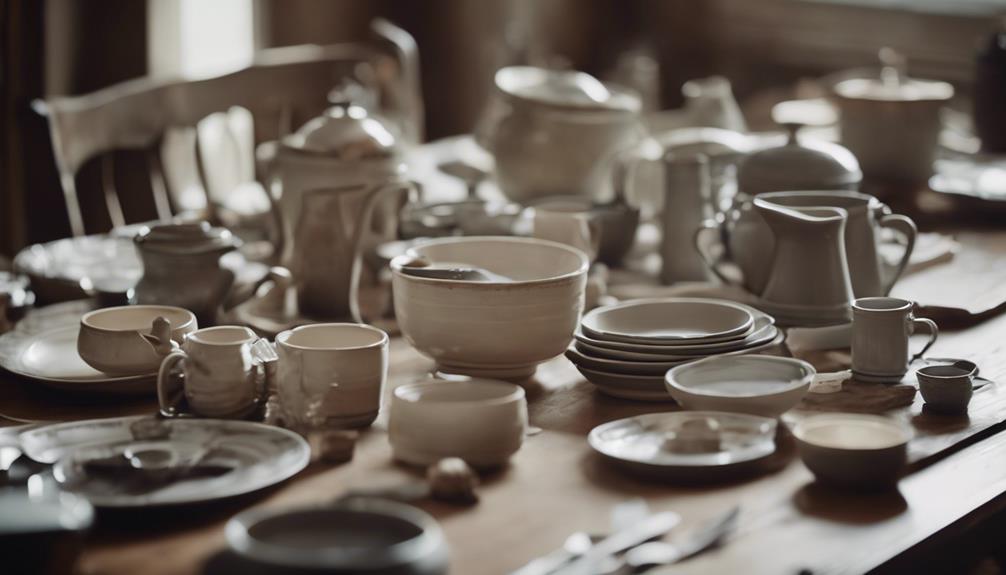
In the journey of tableware evolution, early pottery primarily focused on pots and jars rather than flatware. This shift marked the beginning of a transformation in how tableware was crafted and used. Here are some key points to ponder:
- Precious Metals: Historically, ancient elites favored precious metals like gold and silver for flatware, showcasing their status and wealth through these luxurious materials.
- Trenchers: In medieval times, trenchers – bread rounds used as plates – were common in cuisine, highlighting the practicality and resourcefulness of early tableware solutions.
- Symbol of Wealth: Tableware ownership was a symbol of wealth, with sumptuary laws regulating who could own and display certain types of tableware in various societies.
- Limited Surviving Examples: Plate melting for financial gain during the Middle Ages led to a scarcity of surviving tableware examples from that era, underscoring the economic pressures and challenges faced by artisans and owners.
This evolution showcases how tableware has progressed over time, reflecting changes in materials, design, and societal values.
Tableware Materials and Designs
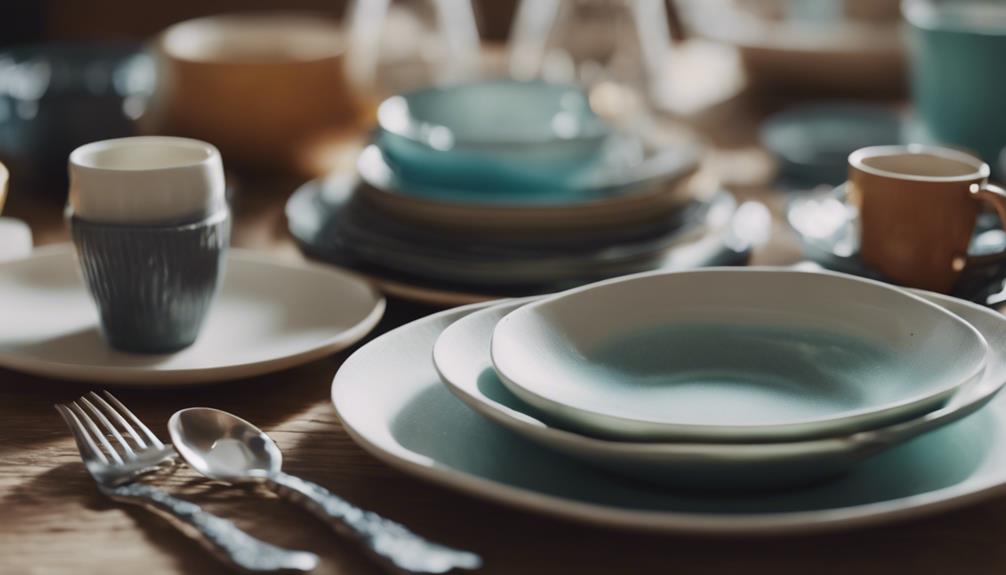
Exploring the diverse array of materials and designs used in modern tableware reveals a rich tapestry of creativity and functionality in dining experiences. Tableware materials range from traditional ceramics such as earthenware, stoneware, bone china, and porcelain to alternative options like wood, pewter, tempered glass, acrylic, and melamine.
Stainless steel, known for its durability and aesthetic appeal, is a popular choice for cutlery in the tableware industry. The global ceramic tableware market, valued at $2.22 billion in 2020, highlights the significance of these materials in the industry. Additionally, the use of disposable tableware like paper and plastic is prevalent, with a growing trend towards sustainability leading to bans on single-use plastic in various countries.
Embracing different materials and designs in tableware not only enhances the dining experience but also reflects a fusion of functionality and style in everyday meals.
Tableware Vs. Dinnerware: Clarifying the Difference
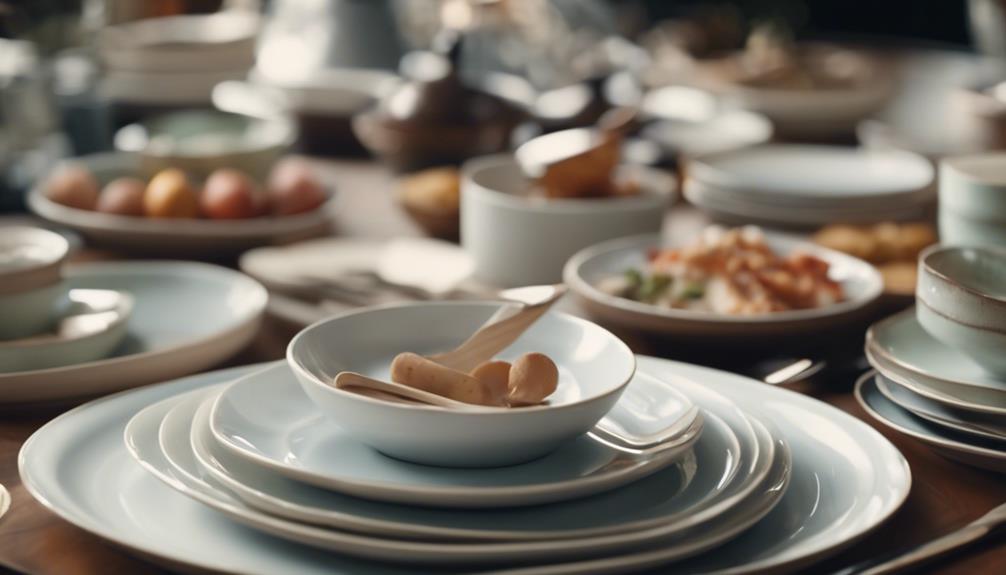
You may frequently encounter confusion between tableware and dinnerware, but understanding their difference is essential for proper table setting. Here are some key distinctions to help clarify:
- Tableware is a broad term: It includes all items used for setting a table, such as dishes, glassware, and silverware.
- Dinnerware is a subset of tableware: It specifically refers to the dishes and plates used during a meal.
- Tableware encompasses more than just plates and cutlery: It also includes serving dishes, glasses, and table decorations.
- Common usage: The term 'tableware' is commonly used in the industry and household settings to describe all table-setting items collectively.
Understanding the difference between tableware and dinnerware allows for accurate categorization of items for various table settings and dining occasions. Whether you're setting a casual brunch or an elegant dinner party, knowing the distinction between these terms will help you create a well-coordinated and functional table arrangement.
Frequently Asked Questions
Is Tableware One or Two Words?
Tableware is considered one word, encompassing dishes, glassware, and silverware for table settings. It's an essential part of dining experiences, including plates, cutlery, and glasses.
The term 'tableware' is widely recognized in meal arrangements.
Is It Silverware or Tableware?
When deciding between silverware and tableware, consider your dining needs. Silverware refers to metal utensils like forks and knives, while tableware encompasses a broader range, including plates and glasses for table setting.
If you're focusing on eating utensils, silverware is the term to use. For a more extensive set of dining items, tableware is the way to go. Choose based on the variety of items you require for your dining experience.
What Is Considered Tableware?
When setting a table for a meal, tableware encompasses all the items you need to serve and enjoy your food. This includes dishes, plates, knives, forks, glasses, and other utensils used during meals.
These essential items not only aid in serving food but also contribute to enhancing your dining experience by adding an element of elegance to your table setting.
Tableware plays an important role in making your meals enjoyable and visually appealing.
What Is the Difference Between Tableware and Dinnerware?
When it comes to tableware versus dinnerware, the distinction lies in their scope. Tableware encompasses all items used for setting the table, while dinnerware specifically refers to the dishes, utensils, and plates used during meals.
Understanding this difference helps in selecting the right items for various dining occasions. Both play a crucial role in enhancing your dining experience and creating the perfect ambiance for your meal.
Conclusion
So, ultimately, tableware isn't just a real word, it's a powerful tool that can elevate your dining experience to new heights.
From the origins and types of tableware to its significance in the hospitality industry and cultural importance, tableware has a rich history and plays an essential role in our daily lives.
So next time you set the table, remember that tableware isn't just a word, but a key player in creating a memorable dining experience.
